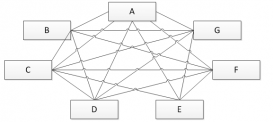第一种:注解配置AOP
注解配置AOP(使用 AspectJ 类库实现的),大致分为三步:
1. 使用注解@Aspect来定义一个切面,在切面中定义切入点(@Pointcut),通知类型(@Before, @AfterReturning,@After,@AfterThrowing,@Around).
2. 开发需要被拦截的类。
3. 将切面配置到xml中,当然,我们也可以使用自动扫描Bean的方式。这样的话,那就交由Spring AoP容器管理。
另外需要引用 aspectJ 的 jar 包: aspectjweaver.jar aspectjrt.jar
实例:
|
1
2
3
4
5
6
7
8
9
10
11
12
13
14
15
16
17
18
19
20
21
22
23
24
25
26
27
28
29
30
|
User.javapackage com.bjsxt.model; public class User { private String username; private String password; public String getUsername() { return username; } public void setUsername(String username) { this.username = username; } public String getPassword() { return password; } public void setPassword(String password) { this.password = password; } } /** *接口类 */package com.bjsxt.dao; import com.bjsxt.model.User; public interface UserDAO { public void save(User user); } |
实现接口:
|
1
2
3
4
5
6
7
8
9
10
11
12
13
14
15
16
17
|
package com.bjsxt.dao.impl; import org.springframework.stereotype.Component; import com.bjsxt.dao.UserDAO; import com.bjsxt.model.User; @Component("u") public class UserDAOImpl implements UserDAO { public void save(User user) { System.out.println("user save11d!"); /*throw new RuntimeException("exception");*/ //抛异常 } } |
操作类:
|
1
2
3
4
5
6
7
8
9
10
11
12
13
14
15
16
17
18
19
20
21
22
23
24
25
26
27
28
29
30
31
32
33
34
35
36
|
package com.bjsxt.service; import javax.annotation.Resource; import org.springframework.beans.factory.annotation.Autowired; import org.springframework.beans.factory.annotation.Qualifier; import org.springframework.stereotype.Component; import com.bjsxt.dao.UserDAO; import com.bjsxt.model.User; @Component("userService") public class UserService { private UserDAO userDAO; public void init() { System.out.println("init"); } public void add(User user) { userDAO.save(user); } public UserDAO getUserDAO() { return userDAO; } @Resource(name="u") public void setUserDAO( UserDAO userDAO) { this.userDAO = userDAO; } public void destroy() { System.out.println("destroy"); } } |
加入aop
|
1
2
3
4
5
6
7
8
9
10
11
12
13
14
15
16
17
18
19
20
21
22
23
24
25
26
27
28
29
30
31
32
33
34
|
package com.bjsxt.aop; import org.aspectj.lang.annotation.After; import org.aspectj.lang.annotation.AfterReturning; import org.aspectj.lang.annotation.AfterThrowing; import org.aspectj.lang.annotation.Aspect; import org.aspectj.lang.annotation.Before; import org.aspectj.lang.annotation.Pointcut; import org.springframework.stereotype.Component; @Aspect @Component public class LogInterceptor { @Pointcut("execution(public * com.bjsxt.service..*.add(..))") public void myMethod(){}; /*@Before("execution(public void com.bjsxt.dao.impl.UserDAOImpl.save(com.bjsxt.model.User))")*/ @Before("myMethod()") public void before() { System.out.println("method staet"); } @After("myMethod()") public void after() { System.out.println("method after"); } @AfterReturning("execution(public * com.bjsxt.dao..*.*(..))") public void AfterReturning() { System.out.println("method AfterReturning"); } @AfterThrowing("execution(public * com.bjsxt.dao..*.*(..))") public void AfterThrowing() { System.out.println("method AfterThrowing"); } } |
配置文件
|
1
2
3
4
5
6
7
8
9
10
11
12
13
14
15
16
17
|
<?xml version="1.0" encoding="UTF-8"?> <beans xmlns="http://www.springframework.org/schema/beans" xmlns:xsi="http://www.w3.org/2001/XMLSchema-instance" xmlns:context="http://www.springframework.org/schema/context" xmlns:aop="http://www.springframework.org/schema/aop" xsi:schemaLocation="http://www.springframework.org/schema/beans http://www.springframework.org/schema/beans/spring-beans-2.5.xsd http://www.springframework.org/schema/context http://www.springframework.org/schema/context/spring-context-2.5.xsd http://www.springframework.org/schema/aop http://www.springframework.org/schema/aop/spring-aop-3.1.xsd "><!-- 要添加最后2行 --> <context:annotation-config /> <context:component-scan base-package="com.bjsxt"/> <!-- 自动扫描 --> <aop:aspectj-autoproxy/> <!-- 要添加本行 --></beans> |
测试类:
|
1
2
3
4
5
6
7
8
9
10
11
12
13
14
15
16
17
18
19
20
21
22
23
24
25
26
|
package com.bjsxt.service; import org.junit.Test; import org.springframework.context.ApplicationContext; import org.springframework.context.support.ClassPathXmlApplicationContext; import com.bjsxt.model.User; //Dependency Injection //Inverse of Control public class UserServiceTest { @Test public void testAdd() throws Exception { ClassPathXmlApplicationContext ctx = new ClassPathXmlApplicationContext("applicationContext.xml"); UserService service = (UserService)ctx.getBean("userService"); System.out.println(service.getClass()); service.add(new User()); System.out.println("###"); ctx.destroy(); } } |
结果:
|
1
2
3
4
5
6
|
class com.bjsxt.service.UserService$$EnhancerByCGLIB$$7b201784method staetuser save11d!method AfterReturningmethod after### |
注意:
@Aspect:意思是这个类为切面类
@Componet:因为作为切面类需要 Spring 管理起来,所以在初始化时就需要将这个类初始化加入 Spring 的管理;
@Befoe:切入点的逻辑(Advice)
execution…:切入点语法
第二种:xml配置aop
实例同上:只是配置文件不同
|
1
2
3
4
5
6
7
8
9
10
11
12
13
14
15
16
17
18
19
20
21
22
23
24
25
|
<?xml version="1.0" encoding="UTF-8"?> <beans xmlns="http://www.springframework.org/schema/beans" xmlns:xsi="http://www.w3.org/2001/XMLSchema-instance" xmlns:context="http://www.springframework.org/schema/context" xmlns:aop="http://www.springframework.org/schema/aop" xsi:schemaLocation="http://www.springframework.org/schema/beans http://www.springframework.org/schema/beans/spring-beans-2.5.xsd http://www.springframework.org/schema/context http://www.springframework.org/schema/context/spring-context-2.5.xsd http://www.springframework.org/schema/aop http://www.springframework.org/schema/aop/spring-aop-3.1.xsd "><!-- 要添加最后2行 --> <context:annotation-config /> <context:component-scan base-package="com.bjsxt"/> <bean id="logInterceptor" class="com.bjsxt.aop.LogInterceptor"></bean> <aop:config> <aop:pointcut expression="execution(public * com.bjsxt.service..*.add(..))" id="servicePointcut"/> <aop:aspect id="logAspect" ref="logInterceptor"> <aop:before method="before" pointcut-ref="servicePointcut" /> </aop:aspect> </aop:config> </beans> |
下面的<beans>是Spring的配置标签,beans里面几个重要的属性:
xmlns:
是默认的xml文档解析格式,即spring的beans。地址是http://www.springframework.org/schema/beans。
通过设置这个属性,所有在beans里面声明的属性,可以直接通过<>来使用,比如<bean>等等。
xmlns:xsi:
是xml需要遵守的规范,通过URL可以看到,是w3的统一规范,后面通过xsi:schemaLocation来定位所有的解析文件。
xmlns:aop:
这个是重点,是我们这里需要使用到的一些语义规范,与面向切面AOP相关。
xmlns:tx:
Spring中与事务相关的配置内容。
一个XML文件,只能声明一个默认的语义解析的规范。
例如上面的xml中就只有beans一个是默认的,其他的都需要通过特定的标签来使用,比如aop,它自己有很多的属性,如果要使用,前面就必须加上aop:xxx才可以。比如上面的aop:config。
类似的,如果默认的xmlns配置的是aop相关的语义解析规范,那么在xml中就可以直接写config这种标签了。
以上就是spring aop两种配置方式,大家了解了吗?之后还有更多关于spring aop两种配置方式的文章和大家分享,一定要继续关注哦













